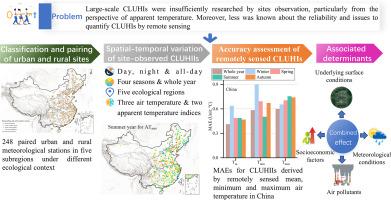基于气温和视温的中国城市冠层热岛监测及影响因素分析
IF 6.9
2区 工程技术
Q1 ENVIRONMENTAL SCIENCES
引用次数: 0
摘要
冠层城市热岛(CLUHIs)与人类福祉密切相关,已被广泛研究。然而,对大尺度CLUHIs的现场观测研究还不够充分,特别是从视温的角度。因此,基于现场观测气温和视温,分析了CLUHI强度的时空差异。在此基础上,通过与现场监测的CLUHIIs进行比较,探讨了遥感CLUHIIs的精度。最后,从人类社会经济活动、城市下垫面条件、气象因子和大气污染4个方面,分析了实测气温和视温对CLUHIIs的14个相关因子。主要研究结果如下:(1) 71.68%的cluhii在- 1.0 ~ 1.0℃之间,最大值为12.96℃,最小值为- 6.47℃。在潮湿条件下,由空气温度和视温度得出的CLUHIIs差异大多超过0.40℃,甚至达到4.95℃。(2)中国南方和北方地区CLUHIIs遥感反演均方根误差(rmse)分别不超过0.94°C和1.41°C。(3)两类CLUHIIs与3个社会经济因子、2个城市下垫面条件、6个气象条件和3个大气污染条件的14个因子之间存在明显的正、负相关关系,具有不同的正、负相关特征和强度。本研究可为建设气候适应型、宜居型、低碳型和可持续发展型城市提供理论依据和实践参考。本文章由计算机程序翻译,如有差异,请以英文原文为准。

Monitoring and determinants analysis of canopy layer urban heat island in China based on both air temperature and apparent temperature
The canopy layer urban heat islands (CLUHIs) are closely linked to human well-being and have been extensively studied. Nevertheless, large-scale CLUHIs were insufficiently researched by sites observation, particularly from the perspective of apparent temperature. Therefore, the spatial-temporal differences of CLUHI intensities (CLUHIIs) were analyzed based on site-observed air temperature and apparent temperature. Then, the accuracies were explored for remotely sensed CLUHIIs, comparing with site-monitored CLUHIIs. Finally, fourteen associated factors were analyzed for CLUHIIs derived by site-measured air temperature and apparent temperature from four aspects, including human socio-economic activities, urban underlying surface conditions, meteorological factors and air pollution. The main findings were as follows. (1) 71.68 % of CLUHIIs were between −1.0 and 1.0 °C, while the maximum and minimum were 12.96 and − 6.47 °C, respectively. Under humid conditions, most differences exceeded 0.40 °C between CLUHIIs derived by air temperature and apparent temperature and even reached 4.95 °C. (2) The root mean square errors (RMSEs) for CLUHIIs derived by remote sensing didn't exceed 0.94 °C and 1.41 °C in Southern and Northern China, respectively. (3) Two types of CLUHIIs presented clear and regular relationships with fourteen factors, featuring varying positive or negative characteristics and intensities, involving three socioeconomic factors, two urban underlying surface conditions, six meteorological conditions, and three air pollutions. This study can provide theoretical basis and practical reference for the construction of climate-adaptive, livable, low-carbon and sustainable cities.
求助全文
通过发布文献求助,成功后即可免费获取论文全文。
去求助
来源期刊

Urban Climate
Social Sciences-Urban Studies
CiteScore
9.70
自引率
9.40%
发文量
286
期刊介绍:
Urban Climate serves the scientific and decision making communities with the publication of research on theory, science and applications relevant to understanding urban climatic conditions and change in relation to their geography and to demographic, socioeconomic, institutional, technological and environmental dynamics and global change. Targeted towards both disciplinary and interdisciplinary audiences, this journal publishes original research papers, comprehensive review articles, book reviews, and short communications on topics including, but not limited to, the following:
Urban meteorology and climate[...]
Urban environmental pollution[...]
Adaptation to global change[...]
Urban economic and social issues[...]
Research Approaches[...]
 求助内容:
求助内容: 应助结果提醒方式:
应助结果提醒方式:


